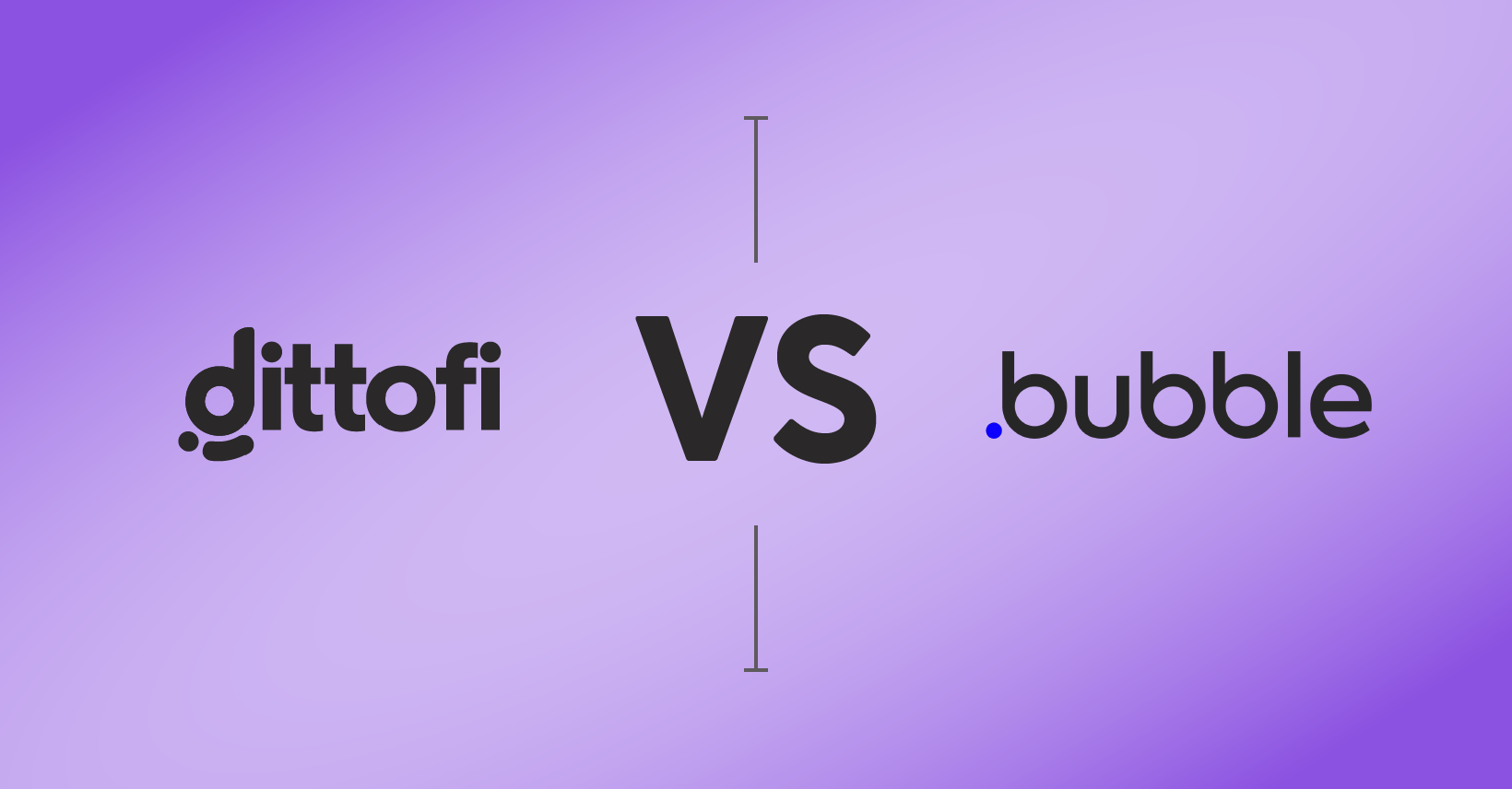In the last year, my team & I have helped hundreds of users switch from Bubble.io & onto Dittofi.
In this article we look at the key differences between Dittofi & Bubble’s no-code app builders.
Of course we will try & remain objective as possible although we are bound to be a little biased.
What is Bubble.io?
Bubble.io (Bubble) is a visual app builder that helps users build customizable web apps with a database backend.
Bubble is similar to Dittofi’s no-code app builder & other full stack, no-code app builder platforms in that it offers a design studio where users can build & host custom software applications that include responsive front end designs, workflows & actions, database backends & integrations.
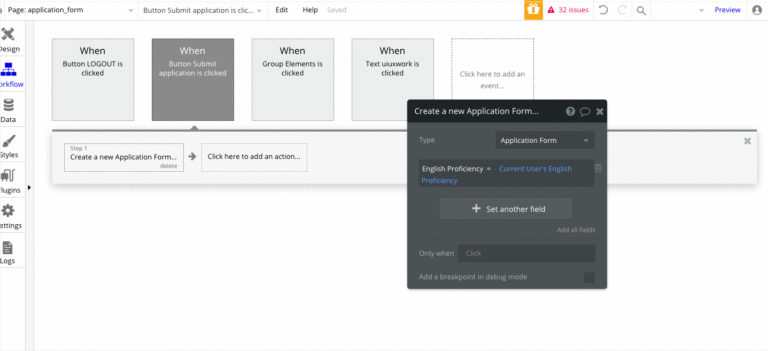
Who is Bubble.io for?
Bubble’s mission is to “erase the distinction between software use & software creation”. Bubble write that by removing the code barrier for application development, anyone is able to build high powered software.
In reality no product has ever been made for everyone. From our own discussions with Bubble users, we have found that Bubble has two main user types:
- Individuals & startups that have spent a minimum of 3 – 6 months & up to a maximum of 2 years learning how Bubble works. The primary resources for these groups are either through online materials or organized face to face courses.
- Software development agencies whose goal is to reduce the time it takes to build custom software applications for their clients. These agencies will recommend Bubble builds for low to medium complexity software builds.
At this point in time Bubble is not considered an appropriate solution for medium to large enterprise software builds due to issues in performance, scalability, IP & code ownership & difficulties with security & data compliance.
Users of Bubble are generally aware that the apps have a limited shelf life. Bubble users often expect to rebuild Bubble apps that (A) start to gain traction, (B) apps that gain a large number of users &/or (C) increase in complexity.
Bubble Cost & Pricing
Bubble operates a freemium model that follows the pricing structure below.
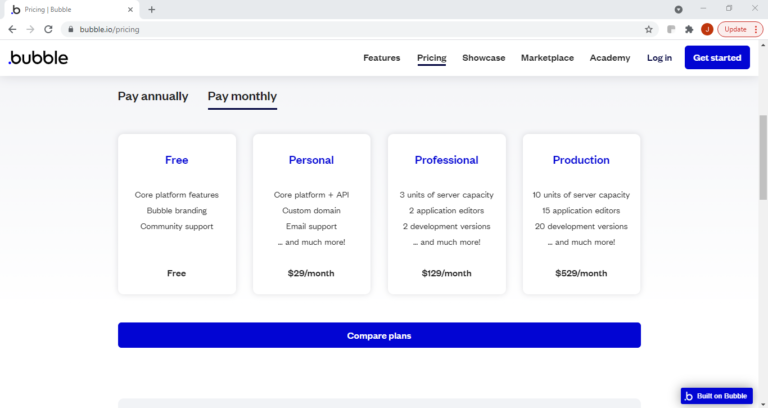
Essentially, the monthly price for a Bubble app will increase the more resources that are required to run the app. For example, if you add a lot of new users to your app, the monthly price will increase. What is slightly unclear about the pricing approach is when & by how much the monthly bill will increase for a Bubble build.
Estimating hosting costs for app development is always difficult & Bubble has tried to make this simpler by using a “capacity” calculation. The capacity calculation is there to help determine how much the monthly spend will be. For us, this makes the situation more grey, since the formula is not exposed on their website.
Bubble also has bespoke pricing for agencies & non-profits which offer really low risk touch points for agencies to get started on their development.
Dittofi vs Bubble A Comparison
Similarities Between Dittofi & Bubble
Both Dittofi & Bubble are visual app development studios that help users build websites & web apps without having to write any code. To this extent, both platforms:
- Allow you to build & publish responsive websites & web apps
- Have an “experts community” of professional development agencies & freelancers. Bubble’s community is more mature, however Dittofi’s is fast growing.
- Offer templates & plugins to jumpstart your app development process.
- Do not require you to know how to write code
Key Differences
Vendor lock-in
Dittofi is the only full stack no-code platform that allows users to export & own their full stack source code. This means that with Dittofi you get full control over your software application & are not locked in.
Bubble by comparison does not allow you to export & own your source code. There are inherent risks in not having control over your apps source code when building apps. Issues that might arise for example are Bubble feature limitations, platform bugs, missing functionality, uncontrollable rising costs, scalability issues & so on.
Not owning the code is not an issue for everyone however, many users choose to take control of their app code & rebuild their Bubble app from scratch after testing their initial idea. Mission critical apps should not be built on Bubble for the same reason. Not owning your code essentially ties you to Bubbles technology roadmap & the natural business & technological risks of Bubble’s business.
One of the main limitations with all no-code platforms is vendor lock-in. Whilst some of the newer no-code platforms (e.g. Flutterflow & Weweb) enable users to export their apps’ frontend code; this feature does not help with vendor lock-in. This is because users are still locked-in to the vendors backend code & hosting to run their applications.
Dittofi is still the only no-code platform that offers zero vendor lock-in & the option for self hosting.
Performance
Compared to Bubble, Dittofi offers vastly superior performance in app development. This is because unlike Bubble, Dittofi transforms visual designs into enterprise grade code. The code that is generated by Dittofi is React on the frontend & Google GO on the backend.
React is a high performance JavaScript framework developed by Facebook & Google GO is a language that was developed by Google specifically handling concurrency & high workloads. Below are screenshots show a comparison of the performance of Dittofi vs Bubble apps on the frontend & backend.
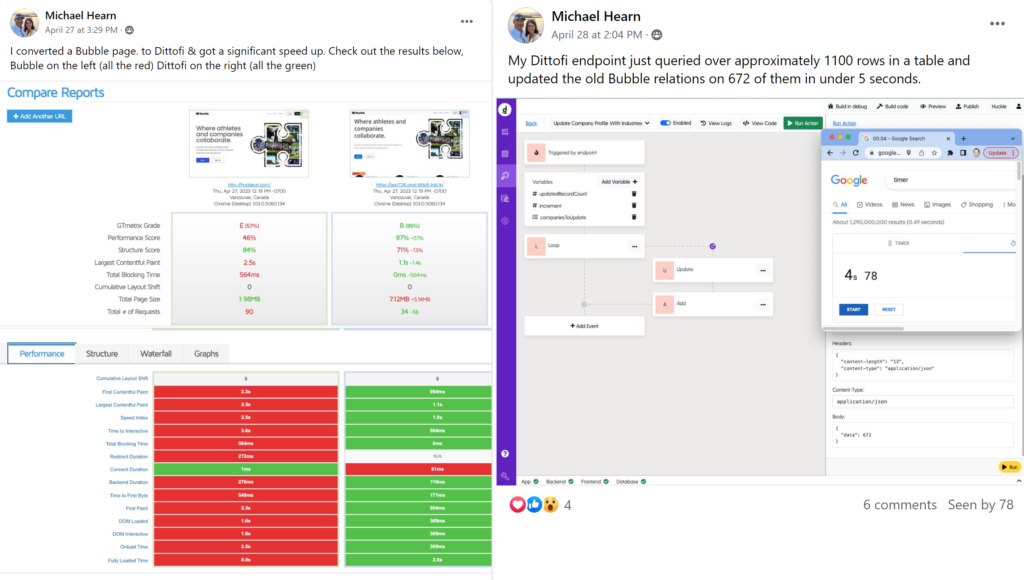
As you can clearly see, the modern technology stack (React & Google GO) generated by Dittofi is vastly more performant than Bubble apps.
Furthermore, as we saw in the section on Vendor Lock-in, Dittofi enables you to export & own your apps source code. This means that you can actually own & further optimize your intellectual property with developers as you scale your solution.
An example of an app that Dittofi built & that ran at scale is the app BestBirdies which is a real-time golfing app: read the complete success story. The BestBirdies app was used to gamify the PGA Qualifiers in Kansas. The app scaled to support 3,500 concurrent users. A video of this live app is shown below.
Scalability
Bubble says that there is no technical limit to how much their apps can scale. In contrast to this strong marketing message, individual app developers & agencies report that Bubble apps running more than 1000 concurrent users get very expensive to run. Bubble development agencies also indicate that apps can freeze up when data loads increase.
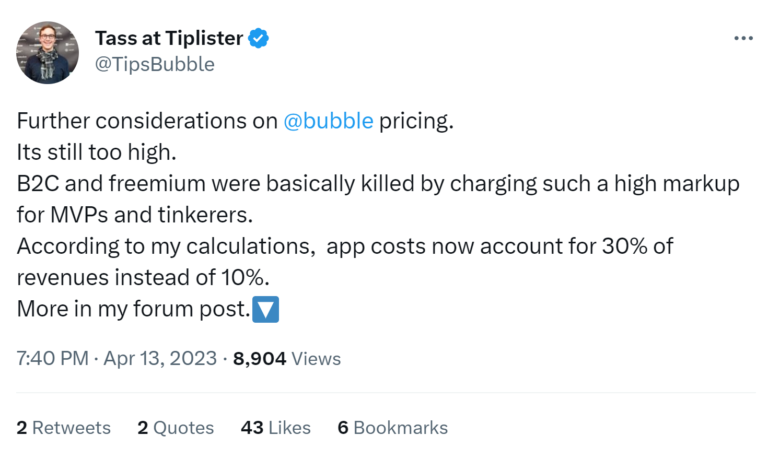
So why do some Bubble users report that their apps scale well & others report that they do not scale? The answer comes down to the way the Bubble apps are architected. Bubble apps do not come with clean & efficient underlying source code. This means that when apps are not scaling well, Bubble will solve these scaling challenges with the use of more computing power. Extra computing power comes at a cost, & so your long term hosting costs for running apps on Bubble are going to be much higher. Of course, this benefits the Bubble business model since they make their money through 100% vendor lock-in however for you, the app creator, this will impact the profitability of your app.
Dittofi by comparison lets you build apps that are extremely simple & efficient to scale. This is achieved by taking a code first approach to visual app development. Dittofi will take your visual designs & transform these into a modern & fast technology stack (React.js & Google Go). Dittofi also optimizes the cost of running your apps even further by running your apps inside an entirely serverless hosting model. This means that you are only charged for app hosting that you’re actually using. You can even use Dittofi’s Automated DevOps Solution to run your app inside your own hosting account. In this case, you will be charged for the cost of hosting your application & nothing more.
Dittofi apps can be scaled both vertically & horizontally. With Dittofi, individuals & teams can build enterprise grade apps that seamlessly expand to accommodate millions of concurrent users on demand, without impacting the speed or performance of your app.
Is building a simple, efficient & scalable app important to you?
Read how the Series A funded company City Row built a high performance app on Dittofi
Flexibility
Dittofi has been built in such a way that it allows 100% customization. This means that the Dittofi platform is necessarily more complex than Bubble. Some examples of where you will find additional flexibility in Dittofi:
1. Bubble apps are more menu driven
Bubble is very menu driven. This makes it incredibly straightforward to build software applications. The downside to this is that the apps that you’ll build with Bubble lack real creativity & app builds can run into road blocks.
Dittofi meanwhile gives you all of the raw components to build an app, but then it’s up to you to think through how you’ll put your app together. On the flip side, with Dittofi you will get the opportunity to build a truly custom app.
2. Frontend builder uses flex-box
Dittofi makes use of traditional programming concepts such as flex-box on the frontend page builder. This means that apps are 100% responsive & generate code that is equivalent to how high quality developers code. Conversely, Bubble use something called “absolute positioning” when creating page layouts. This appears more intuitive at the outset, but ultimately causes problems when looking to scale your app usage.
Learning Dittofi is therefore a trade off. On the one hand the apps that you can output with Dittofi are vastly more custom & powerful than Bubble apps (& you own your code). On the other hand it takes between 8 – 10 hours to onboard onto Dittofi.
Maturity of the total solution
Bubble has been around since 2008, whereas Dittofi has only been around since 2020. This means that Bubble has matured their offering, has a strong online presence & an active community.
Comparing Bubble to Dittofi, Dittofi has all the benefits of being late to the no-code party. Dittofi has watched the pioneers of the no-code movement develop their products & has seen gaps in existing technologies. This has allowed Dittofi to build a no-code product that is right on the frontier of no-code innovation. With a great product, Dittofi is seeing the community increase rapidly & there is an increasing online presence.
Become a Marketplace Insider
Join our inner circle for exclusive insights, coveted trade secrets, and unparalleled strategies – your journey to marketplace dominance begins here.

